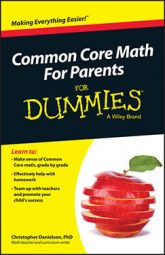Want to avoid raising a math‐o‐phobe? Here are five proven ways to help your child become successful in his or her Common Core math classes.
Talk about math together
Set yourself a goal to ask "how many?," "what shape?," "how do these compare?" and "how do you know?" at least once a day. Don't worry about asking a question that's too difficult; your child can take a guess, and then you can talk. You don't need to know a lot of math in order to support your child's learning. You may even be a little afraid of math, which is okay. Talking about numbers and shapes with your children is a low‐risk activity.
Talk about math together in the car, on the bus, at the dinner table, or while walking the family dog. Here are some simple sample prompts for you to try:
How many crackers (or grapes, or apple slices, or pieces of cheese) would you like for your snack?
How many legs do you think are in your collection of toy animals?
Peruse your child's notebook
Parents tend to rely on two sources of information about what is happening in math class from day‐to‐day: the child's answer to the question, "What did you do today?" and the homework that is assigned. The first is notoriously unreliable, and the second can be a source of stress.
Another way to get a handle on what is happening in class is to look at your child's notebook and ask questions about what you see there. You can ask when it isn't homework time and with a spirit of inquiry. What you see will bring back memories of learning the same content (perhaps in a different way). Share those memories. Connect with your child for a few minutes. He may start making better and more interesting notes.
Play board games
Board games (and card games) are lovely ways to engage young children's minds. Talk about the game as you play. Make a big deal about what you hope you'll get on the next roll or draw of the card. Talk about how likely it is that you will. Discuss whether you got what you hoped for and the difference between it and what you actually rolled (or drew).
Shop together for groceries
The grocery store has a wealth of opportunities to discuss numbers and shapes. Here are some examples:
Do all the jam, jelly, and mustard jars have circular bottoms? If not, what other shapes can we find?
If you're paying cash, which bills and coins should you pay with? How much change should you get back?
Is a $3, 24‐ounce jar of peanut butter a better or worse deal than a $2, 16‐ounce jar? How do you know?
Build things together
Spatial visualization is an important skill for developing an understanding of geometry and (perhaps surprisingly) other areas of math as well. One of the best ways for your child to develop spatial visualization skills is to build things. You can provide blocks, boxes, sugar cubes, toilet paper rolls, cardboard, whatever. When your child imagines how he wants the structure to look and then compares his imagination to the reality, he will develop his spatial visualization skills. You can build together with your child, or he can build alone or with friends. What matters is that he gets time to imagine spatial relationships as he plays.

